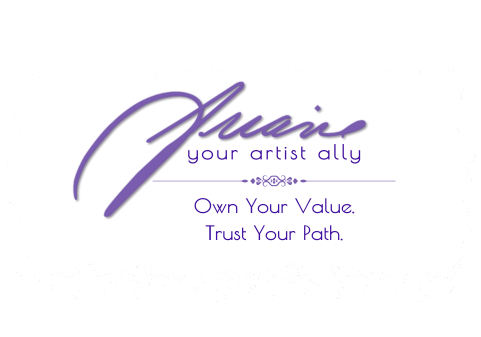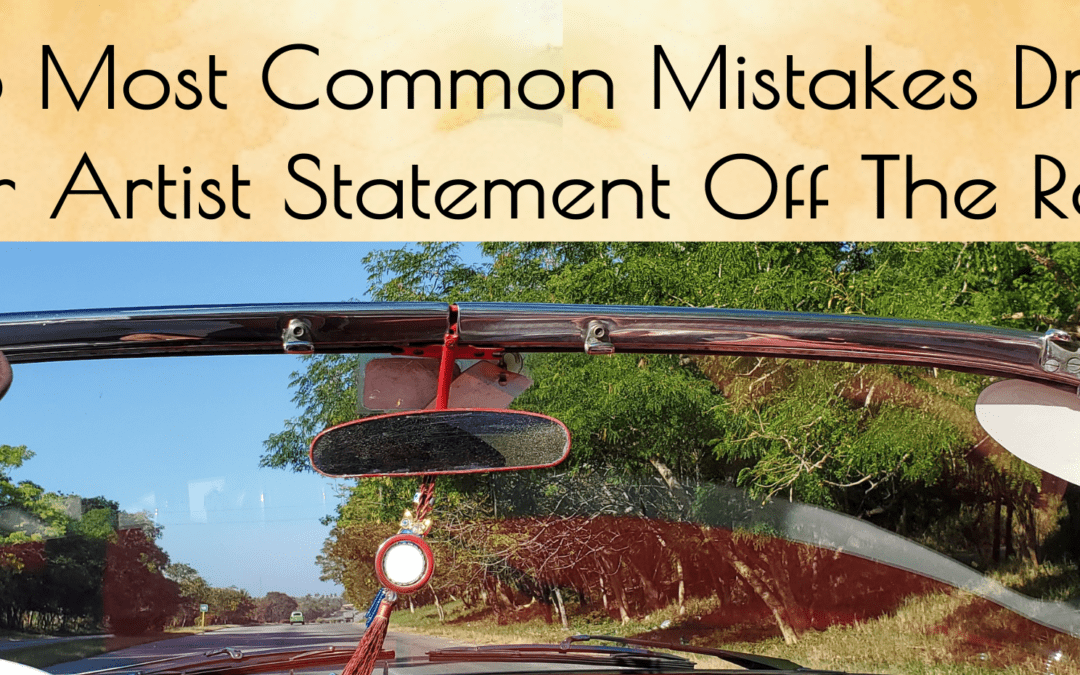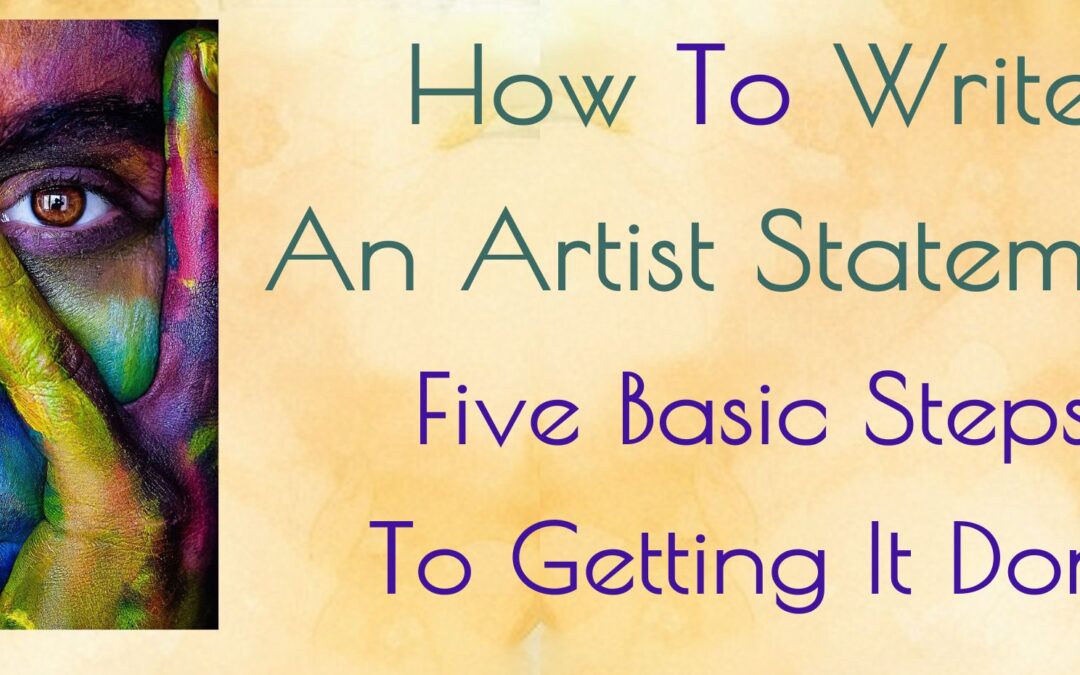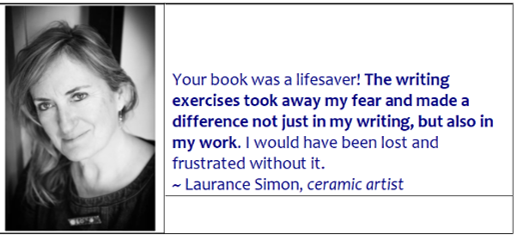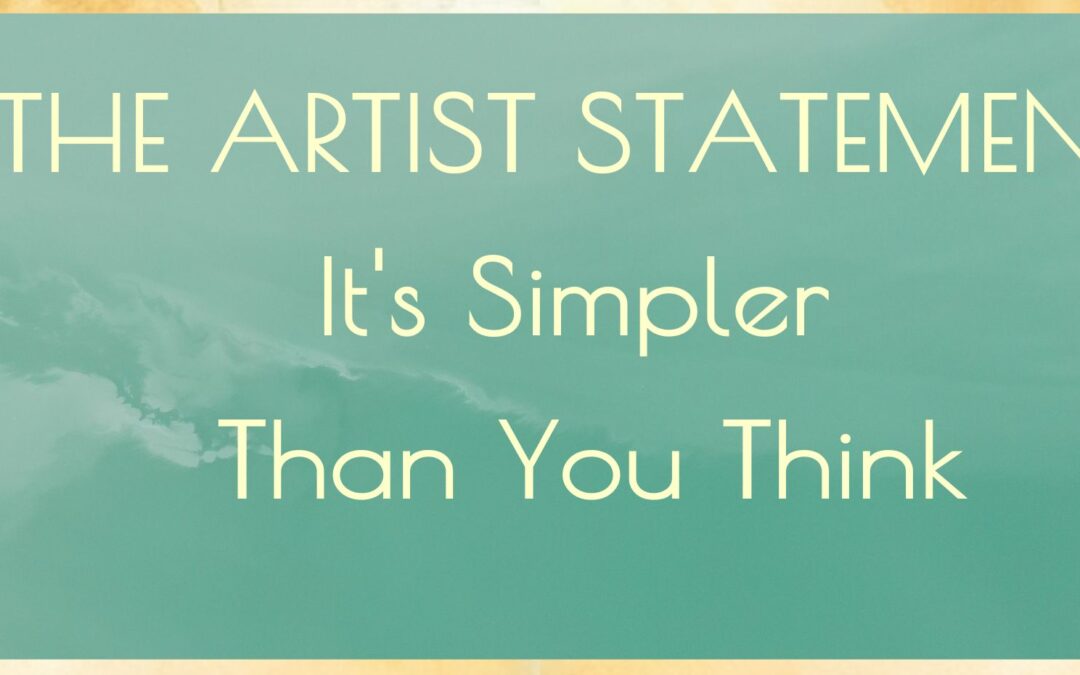
The Artist Statement: It’s Simpler Than You Think
How many drafts have you started and tossed out?
How long have you stared at a blank sheet of paper?
How many times have you gotten tangled up in your own web of words?
(Do you even have a web of words?)
What other things have you managed to get done in order to avoid writing your artist statement?
Maybe it would help if you thought about an artist statement as a bridge between two worlds: your inner landscape and the outer world you interact with.
A bridge between your personal experience making art and the people viewing your art.
If you are not used to connecting the outer world and your inner world in a conscious, attentive manner, it can sometimes feel pretty uncomfortable. If that is true for you, a good place to start is with is just noting the discomfort, maybe asking yourself What, exactly feels so uncomfortable?”
Is the discomfort about having to deal with the unfamiliar? Is it a concern about how you write? Is it a worry that you don’t have anything worthwhile to say? Is it anxiety over what you might say that will turn your views off?
When you can specifically name the discomfort, instead of brushing it away (or worse, falling prey to its mandate of Don’t do it!) For many artists, it’s just discomfort with the unfamiliar.
When you can notice the discomfort and continue anyway, then you can avoid the discomfort dead end. Think about how many times you’ve been working on a piece when you arrive at a place where you are not sure what’s next.
Imagine if, every time this happened, you stopped working. You don’t stop working because, as an artist, you know uncertainty, doubt, and the unfamiliar are part of your creative process.
So, isn’t it interesting to think about where the unfamiliar stops you anywhere else in your life?
Here’s An Artist Statement Tale Of Two Stories
#1: The Gallery That Wasn’t
Once upon a time an artist contacted me because he had a gallery in SoHo who wanted to show his work. But, they needed an artist statement. By the time he got in touch with me, a year had passed since this gallery’s request. The outcome? He was still not showing in that gallery. Why? Because he had not written the artist statement they needed.
#2: Sale. Sale. Sale.
Another artist asked me for help in writing her first statement, which we did. In our process, she kept noticing where she was tempted to hide her more vulnerable, personal self—the one who creates art—behind aloof words and spiritless sentences. Imagine her surprise, after her more personal, completed statement was put in a show, when a collector told her that the artist statement was what convinced her to buy three pieces.
Now, it’s true that an artist statement isn’t going to take the place of good artwork. This artist’s work had already called out to this collector; and it’s also clear that layering her artist statement alongside the artwork sealed the deal—not one, mind you, but three.
I assure you, the artist statement is what I call “an indispensable grain of sand in your artist’s shoe”—small in scope; mighty in impact. It demands your attention with good reason.
Your Twin Powers: Art + Words
We are creatures of language. Language owns us long before we make meaningful marks. Without language, we cannot name or understand our world, internally or externally.
So why artists persist in suggesting, or outright declaring, that their artwork “speaks for itself” is confounding.
Yes, visual language is powerful, compelling, has the ability to imply story, emotion, and meaning making. What it cannot do is “tell” us anything personal about the artist. Every piece of artwork, while it is from an artist and definitely implies a certain something about the artist, this implication is shrouded in the indirect effects: of color, shape, placement, relationship of marks, evocative imagery, and so on.
We can walk away musing, transformed, confused… but we cannot walk away with a deeper understanding of the artist behind the work; or the work in relationship to the artist’s experience while making it.
In our human need for multiple levels of communication, the visual world—though mesmerizing, or disturbing, or profoundly moving—does not replace, displace or remove our need for language.
Words may feel inadequate, more off than on, less intimate than an image; but words are persistently there in our heads, coming out of our mouths, inching their way across paper or the monitor screen. Whatever misgivings we may have, words are there all the same, and all the time.
It serves artists well to learn to use words to their advantage.
The Language Paradox
I have a theory I’ve talked about many times. I call it the “public-private paradox of language.”
When we come into the world, language is one way that we orient ourselves. Children naturally begin to speak. They speak the language of the culture that they are in. It’s as natural as breathing, as learning to roll over, then crawl, and then walk.
In the beginning, language is private. It is ours; we own it. It sits and lives in our bones.
Then something starts to change. The language that we are so enmeshed with, that is so much a part of who we understand ourselves to be as we start to move in the world, becomes more public.
It can start with caretakers, parents, even siblings who insist: say it this way, don’t say that, no, it’s (fill in the blank). When we start school, the change is irrevocably cemented. All of a sudden our private, deeply personal language becomes regulated by other people telling us when we can say what. Our private language enters a fierce arena where it becomes controlled by those holding positions of authority.
And so, the public-private paradox of language begins its tug of war inside of us.
Flash forward.
Now we are adults working with something as private, intimate, and deep as our art, and we are going to put words to it? Hmm, I don’t think so.
Having to write an artist statement can yank us back to early, early memories when language was taken from us in a very basic kind of way. The good news is that we can learn how to reframe this and work around it.
Why Artist Statements Get a Bad Rap
I don’t know about you, but for me, I find that most of them are simply badly written.
And they are badly written for one of several reasons.
Either the artist doesn’t understand the reasons for writing their artist statement, and so tries to explain things out of their viewers’ cognitive reach; or the artist postures, telling us about the art and why it’s so great.
Sometimes, artists try to be clever, and end up confusing or just annoying us. Other times, the sincerity is there, but the content is not.
A lot of this is simply because no one has actually defined an artist statement or told you it’s IRL purpose.
I find it easiest to start with what an artist statement is not, before saying what it is.
So, Let’s Clear Up Some Misconceptions
First, an artist statement is not a bio.
The tricky part, here, is that your artist statement might have some of the same elements as your bio. For example, the fact that you watched your father turn a lathe impacts why you create burl vases now. This may be important enough to be a key piece of an artist statement, or it may not. But the entire artist statement will not be a biographical statement.
The key is weaving only a few, specific biographical facts into your artist statement that relate to why, how, and what you create.
An artist statement is also not a critique.
You are not asked to comment about your art, what it means, what it is, good or bad. Of course you’re always going to say it’s good, right?
But by critique, I’m talking about any language that implies a value system, which we’ll leave up to our viewers and the art critics. “Beautiful,” “inspiring,” “soulful,” “meaningful”—these are all terms I have seen artists drop into their artist statements.
And you don’t want to do this for one, critical reason.
Judging what they are seeing is the job of your viewer, your collector, and your audience… not you.
They are going to look at your art and say, “Oh my, that is so beautiful it takes my breath away.”
When you do this for them, when you jump in to tell them what their experience is going to be, you cut them off from connecting with your work. So it is critical that you stay away from value-laden language.
Besides sounding self-serving, these comments are irrelevant to the core purpose of your artist statement: to give your viewers a peek behind your process, a nod to why and how you do what you do.
The Authority of Personal Story In Your Artist Statement
No artist statement worth its salt will try to speak for your art, because it is not about your art per se; it’s about your relationship to your art.
And that is a completely different story, yes? One that your collectors are dying to hear.
There are two things you might want to understand:
- What might be obvious to you in what you are doing, is not necessarily obvious to anyone else.
- Everyone loves a personal touch. They want to rub shoulders with the artist, they want to get a peek behind the canvas, or the marble, or the choreography. Everyone.
We’re hard-wired for story. We thirst for story. When you know something about another person, you establish connection, and when you establish connection you build trust.
So you could say that an artist statement is about building trust. And when someone sees your work, and also has a sense of trust, they are more confident about buying. As they also say, we don’t like to be sold to, but we love to buy.
And, as they also say, trust is not given, it’s earned. The artist statement earns a viewer’s trust, a critical step before buying your artwork.
How Gender Influences Your Artist Statement
A convincing artist statement oozes with confident clarity based on nitty-gritty details. But, sometimes, there are a few mental landmines we need to clear out.
Women can worry about overstating their abilities, and with good reason. When a woman speaks up about what she’s good at, the culture calls it boasting. When a man speaks up, the culture calls it confidence.
I worry for the women who don’t speak about their talent because, at the heart of it, they don’t truly believe in their abilities in the first place. In general, men don’t often hesitate because they seem graced by a culture that validates their right to be good at something. This doesn’t mean men don’t have issues with believing in themselves; they just aren’t usually concerned that if they believe in themselves it means they are stepping on someone else’s toes.
Women and men need to learn that we are all allowed to toot our own horns. We can create authentic hype. God will not strike us down with lightning, nor will we be visited for seven years by locusts, boils, or the plague.
This is reserved for those who toot their horns and step on the gas at the same time, which is where I think tooting our horns got such a distasteful reputation in the first place.
The Simplicity of Your Artist Statement
An artist statement is personal. It’s as personal as your art. It’s also honest. In the same way your art reflects a true expression of your being, your artist statement needs to speak to the authentic you at work. When it’s done well, the two support each other.
In Part 2 of this series, we’ll explore practical techniques for capturing your authentic voice and crafting a statement that truly represents you and your work. We’ll dive into specific exercises and examples that will help you write an artist statement that connects deeply with your audience while staying true to your artistic vision.
This book—Writing The Artist Statement: Revealing the True Spirit Of Your Work—will push start the process of writing an earnest and meaningful artist statement.
It is motivating, reassuring and provides an easy workable approach that removes the barriers to writing your statement.
Complete the exercises and your finished statement will connec the artist to the artwork in a way that others will enjoy and understand.
This book is a great addition to any artist’s reference library.
~ R. H. McMurray, ex-president of the Federation Of Canadian Artists

